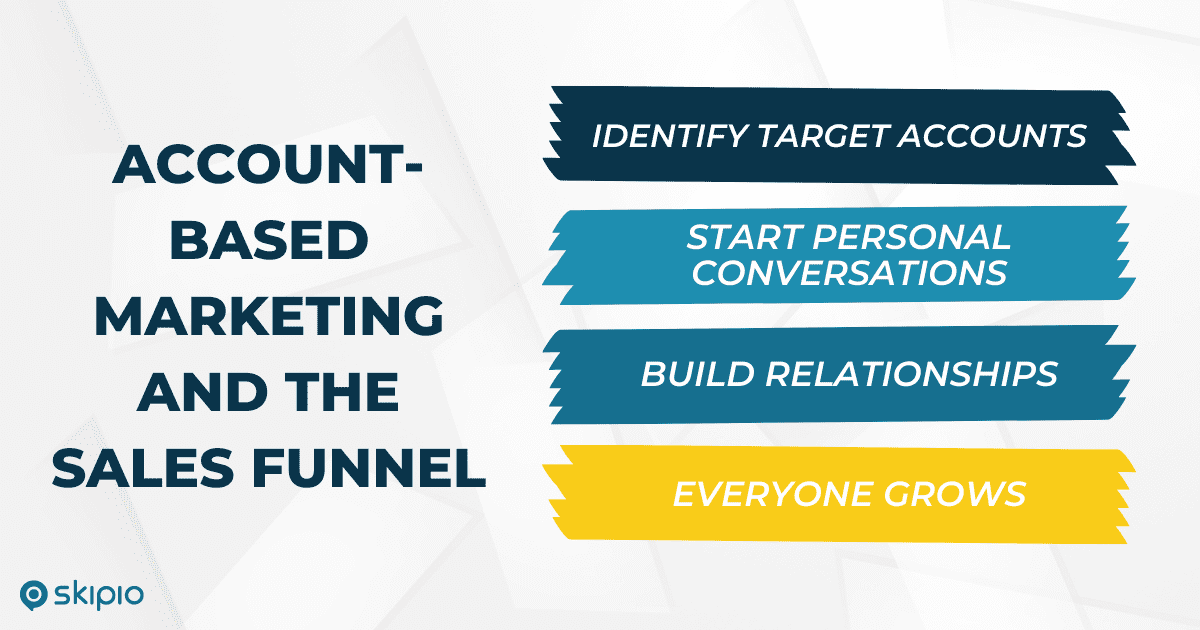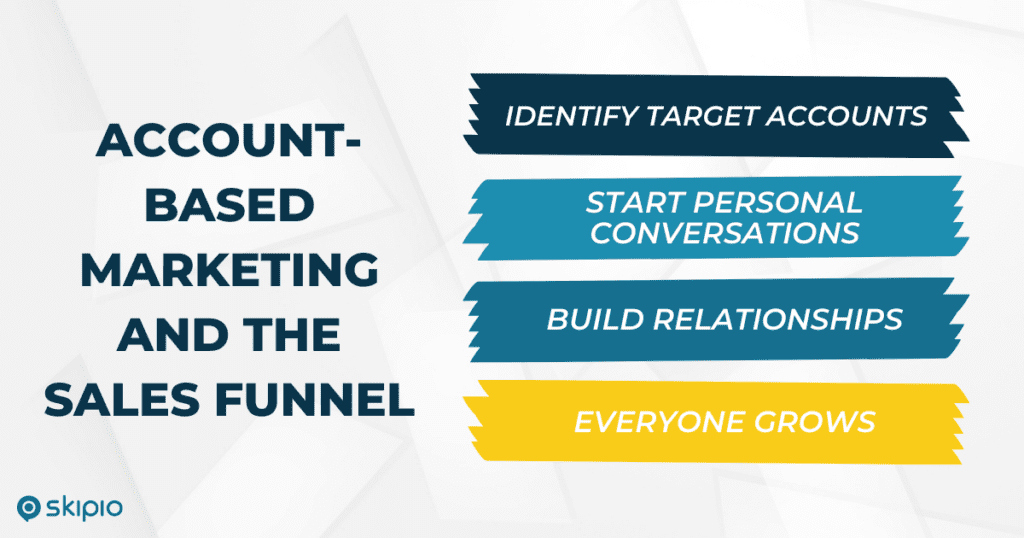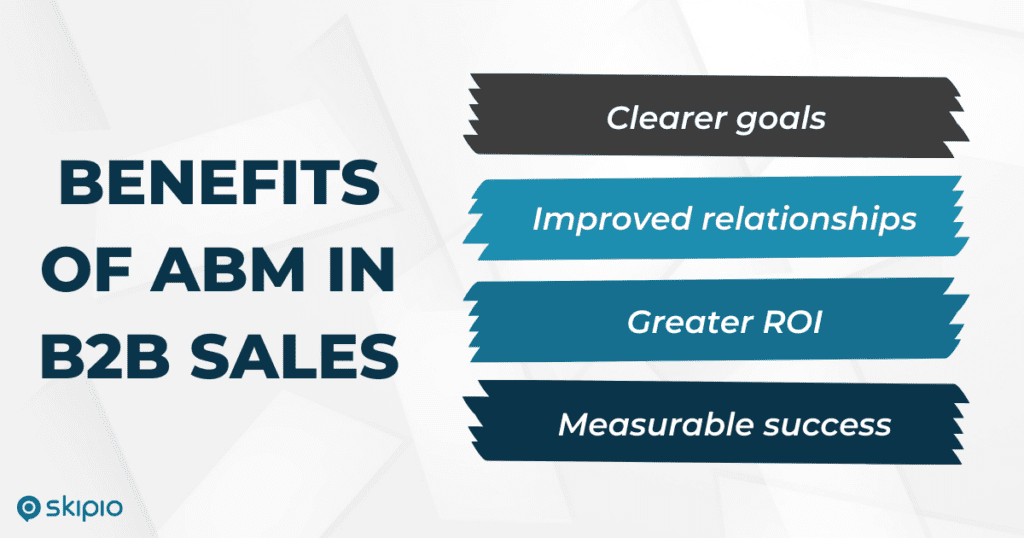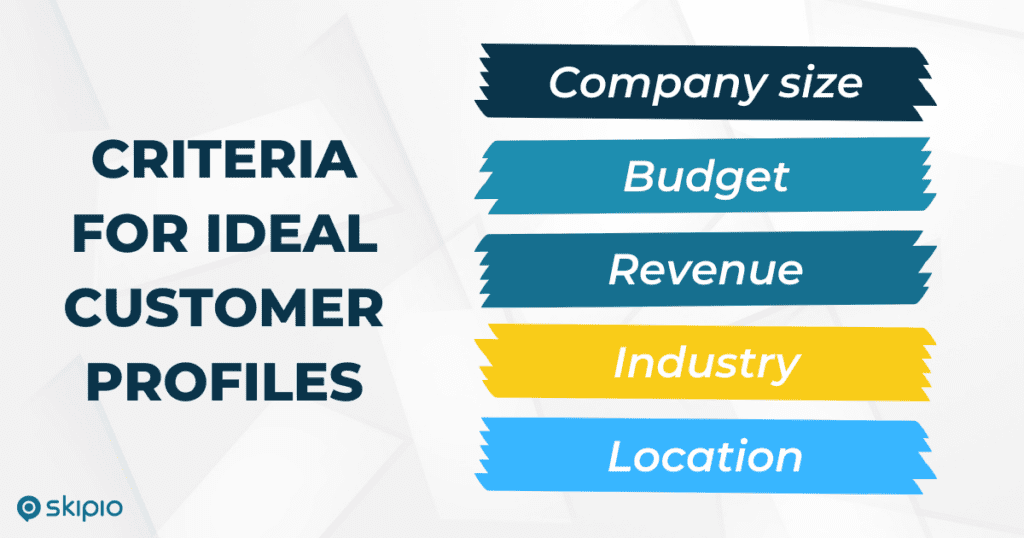
People continue to reward authenticity when it comes to business purchasing decisions. They like supporting and working with other companies that show genuine investment in them as a buyer. They like spending their money on brands that understand them.
So for companies that want to make personalized, authentic customer experiences the norm in B2B marketing and sales, account-based marketing is the logical strategy.
Account-based marketing (shortened to ABM) works because you provide a personalized buying experience to the companies you want to sell to. Instead of hoping people will find you and purchase, you go to them with clear solutions.
With this approach, you prioritize two-way communication and build relationships with the relevant decision makers at a company. That’s how you close a deal for a long-term customer.
So let’s now get into why exactly account-based marketing has grown so popular and how you can start implementing ABM strategies at your company.
What is account-based marketing?
How ABM fits into the sales funnel
Why ABM is important in B2B sales
Who needs to be involved in account-based marketing campaigns
How to start implementing ABM strategies
Tools and software you need for successful account-based marketing
The #1 tool teams aren’t using enough for ABM
What is account-based marketing?
Account-based marketing is a clearly targeted effort by all teams to find and sell to the “perfect fit” customer from the very start. Marketing isn’t just generating and dropping off leads for sales reps to grab in a round-robin, everyone hoping that the leads are good enough to eventually convert.
With ABM, you specifically find, market to, and sell to companies that can successfully use your product to make a positive impact in their business.
This strategy of marketing and selling ultimately blurs the line between what counts as “sales” and what counts as “marketing.” To find the ideal customers to sell to requires close collaboration from research and discovery to signing contracts.
Here’s a basic ABM framework, and later on I’ll explain these steps in detail.
- Research and compile info on what makes an ideal customer. Know the pain points and needs of who benefits most from what you sell.
- Specifically search for companies that appear to be ideal customers. This includes looking at current customers. Each company you identify counts as an individual “account” for you to market and sell to.
- Market to and engage your target accounts, doing personalized outreach with tailored content. Targeting an account includes building relationships with decision makers at a company and proving that your solution is the one for them.
- Land the deal. Your team has reached out consistently and personally, addressing all the questions and concerns of stakeholders from the target account. You’ve made connections and held conversations that will lead to signing a contract.
Active collaboration between the sales and marketing teams is key to successful account-based marketing.
How ABM fits into the sales funnel
Account-based marketing isn’t at odds with your current sales funnel. It’s just a different perspective and strategy.
If you currently do inbound marketing, a lot of what you’re already doing applies to ABM campaigns. With account-based marketing you have prospective customers, do personalized outreach, build relationships, share content… All of that.
However, you do it in a slightly different order than you would for inbound, repurposing content specifically for target accounts. Basically, instead of letting leads come to you, you go to them.
You’re not running ads and hoping someone will pay attention to your marketing, waiting around for them to some day fill out a form. With ABM, before you ever even talk with someone at a company, you already know that they’re a fit for what you sell and have a set plan for connecting.

You’re not running generalized marketing campaigns that might hit a “perfect fit” client if they happen to be in the right place at the right time. You’re running highly targeted marketing campaigns that are guaranteed to hit the “perfect fit” because you’re only going after that fit.
If you have the employees and audience to sustain both inbound marketing and account-based marketing, each can and should be done at your company.
Benefits of ABM in B2B sales
Account-based marketing gives your potential clients a more personalized experience and streamlines the whole sales cycle on your end. Here’s a handful of reasons how ABM benefits companies in the B2B space.
Clearer marketing and sales goals
For ABM to work, sales and marketing teams must closely collaborate. Those involved will get specialized training, learn the true value of what you sell, and come up with shared goals. People will know exactly what their responsibilities are, what KPIs matter, and who to go to if they have questions about other aspects of each ABM campaign. In some ways, ABM “forces” each team on the same page.
With this alignment, all sales and marketing tasks go more smoothly because people are all invested in the same things. Everyone knows the common goals and holds each other accountable.
Improved customer relationships
Even at smaller companies, rarely is a single person making a purchasing decision. Account-based marketing takes into account all related decision makers and their pain points. Members of your team will develop close working relationships with those decision makers.
Those relationships and a clear understanding of a target account’s problems and how to solve them results in happier customers.
Plus, the most human brands win the most business. The right ABM strategy allows your team to show off all the wonderful humans who make the business run. People know they’re talking to other people and not just getting automated generic marketing blasts.
Greater ROI for your company
ABM is a huge undertaking. Because you take greater care in how you spend your time and who you’re selling to, those customers ultimately spend more and stay longer. You’re only worrying about companies that you know fit.
In addition, the alignment between sales and marketing makes you more efficient and overall more profitable. People spend their time on what matters most and aren’t engaging in as many tasks or activities that don’t help you generate revenue.
All the work you put into targeting the right accounts and delivering personalized experiences also benefits your company’s other marketing efforts. The sales and marketing people who aren’t involved with your ABM strategy will quickly learn the power and importance of genuine conversations and individual interactions.
There’s no reason your inbound marketing should not include fast and personal outreach, consistent follow-up, and industry-specific education/content.
Prioritization of measurable success
Not all marketing and sales efforts can be measured. (It’s important to accept that.) But by adopting account-based marketing you ideally also adopt growth marketing strategies and focus on conversion rate optimization.
How will you know your efforts were worth it in converting a targeted account and how will you keep improving? You’re going to test and track your impact, impressions, effectiveness of content, the amount of time put into each campaign, and the CLV of that type of customer.
Then what will you do with that information? You create future ABM campaigns that more effectively target other companies. Your past campaigns should 100% influence what you do next time.
Focusing on data while you also build relationships is how you win at account-based marketing and closing sales.

Who’s involved in creating ABM campaigns?
No single person does account-based marketing. It’s a major team effort. That doesn’t mean you need a huge team, though. Multiple of these roles can be taken on by the same person. As long as someone covers these responsibilities, you have a scrappy ABM team!
Campaigns manager: This is the person who makes sure everything gets executed to plan. They oversee the setup of campaigns and communicate with everyone to ensure the right content is prepared and delivered and that follow-up is happening in a timely manner. They manage, coordinate, and align with all the teams involved.
If you’re not going to have a full-blown head of account-based marketing, this is probably the person you want handling reporting and overseeing all things ABM.
Digital marketer: From landing pages to paid ads, you have to be on top of your digital game. Your digital marketing efforts should be neatly aligned with all of your ABM campaigns, no matter the target account.
Content manager: Account-based marketing only succeeds when you deliver personalized content to your target accounts. Your content manager must create and/or source the content that makes up each of your ABM campaigns.
Sales reps: As we’ve established, ABM does not stop with the marketing team. SDRs and account managers or whoever else from sales must know the customer profiles and make personalized follow-up their top priority. Slow, generic engagement on your end may break your opportunities with target accounts. The sales team will work closely with the content manager to get the right content delivered at the right times.
Marketing ops: The data and outcomes of every ABM campaign influence your future success. You need to know exactly how you’re performing every step of the way. With a solid understanding of growth marketing and CRO, your marketing ops manager will absolutely transform how you do account-based marketing.
How to start implementing ABM strategies
If I didn’t make it obvious already, it’s a big deal to adopt account-based marketing. You won’t have a fully developed ABM strategy overnight. But where to start?
Here’s a step-by-step framework for starting to implement account-based marketing at your company.
Know who your ideal customer is
Why do people want to buy from you and not someone else? You must start with the “why” before you can find the “who.”
Anyone who wants to do account-based marketing needs to put together a strategic plan based around ideal customer profiles and then buyer personas. It’s the fancy marketing way of saying your team knows who you should sell to based on their main problems and why your solution is the best for solving said problems.
Ideal customer profiles help you identify the types of businesses that would benefit most from using your products. They include information like:
- Company size: If your ideal customer has a sales team of ~25 people, you don’t want to spend time targeting a company with 3 sales reps. You aren’t the solution for them, and that’s okay!
- Budget and revenue: You only want to target companies that can actually afford what you sell. In addition, certain products only benefit companies that bring in a certain amount of money.
- Industry/vertical: Sell to the people who actually need and use what you sell. Even if your product can technically be used by any type of business, there are specific industries that will really resonate with what you do. Go after businesses in those industries.
- Location: If you don’t offer services in Canada, you can’t sell to a Canadian company, no matter how perfect of a fit that company is otherwise.

Once you do an ideal customer profile, then you create buyer personas. You probably already have a version of these if you do inbound marketing. Buyer personas focus on the individuals at a company who have a problem that you can solve. These are your decision makers, the people you’ll contact within each target account.
Customer personas for ABM include information like:
- Metrics they care about: In their everyday role, what are they trying to accomplish and how is it measured? This includes big metrics, like say MRR, to niche metrics, such as response rates to a first text message. Narrow in on how they define success.
- Hard and soft skills they possess: What skills and traits do they use to do their job successfully? What areas do they often struggle with or need to improve?
- Biggest business challenges: What problems affect them daily, quarterly, etc. and how do these problems affect the overall success of the company? Are they directly responsible for solving any business challenges? In other words, know what causes them stress regularly.
- Makeup of their team (if they manage others): Do they manage a few direct reports or an entire department? What roles are their team members in?
- Communication preferences: What’s the best way to contact them and get a response? Are there specific tools and platforms that they use at work?
- Search strategies and tendencies: Where do they go online to look for solutions and who do they trust to give them recommendations?
- Favorite products or past solutions: What have they already tried and how did that go? Do they use any systems that compete with what you offer? What do they love about the solutions they regularly use, even those that have nothing to do with what you sell?
Without knowing what problems you solve and why you’re good at solving them, you won’t be able to identify the companies and people that could use your help that you hope to sell to.
Unify your sales and marketing messaging
You can’t start identifying target accounts or reaching out until everyone involved understands your ideal customer profiles and the people who work at the target companies.
Everyone needs to know the problems you solve and your value as a solution. Your content creator(s) and sales reps must know how to talk about your solutions to different stakeholders for the accounts.
For instance, the language that your marketing team uses in assets needs to reflect the language the sales team uses when calling, texting, emailing, video chatting, etc. Not that you’re robotic, but it should all feel cohesive.
Learning about your ideal customers and figuring out your ABM team’s overall goals should initially happen in more formal trainings. Dedicated trainings about your “why” for different targets and verticals get the team going on the right path.
Just make sure you’re continually talking about your customers and the goals of ABM. You’ll definitely need to realign at times or even completely shift focus. Master this alignment and you close more deals.
Identify target accounts
Once everyone knows the ideal customer to go after, get searching. You’ll use a multi-channel approach to find and identify target accounts.
Start off by looking in your current database of hot leads, old leads, current customers, and past users. Match what they do with your customer profiles. Even look at the competitors of your clients who also match those profiles.
In addition, get your marketing and sales teams active on LinkedIn and looking for opportunities to connect. In this initial stage, they don’t need to be doing anything but connecting, following, and engaging with people who work at the companies that could be target accounts. They’re just there to observe, engage, and learn. No pitching required.
Automate parts of your search by using ABM software that helps you predict who to go after based on your customer criteria. Gather contact info and whatever else you can about what that company is trying to accomplish right now. Maybe they’re hiring a lot or you notice that they’re gearing up to raise funds. All of those details can indicate whether or not they’re a good target for now or in the future.
Not every company that you initially think will be a good fit will end up being a target account. That’s okay! It’s good even. It means you’re only going after accounts that have the highest potential.
Once you identify a number of target accounts that meet your ICPs, go in-depth on how they function and who makes decisions. Learn each account’s exact needs and pains, paying special attention to whether or not they’re already in your funnel somewhere, whether as an individual lead or a current customer.
If a target account already uses your products, that will affect how you approach them and how you sell. They won’t need the same base education on your services and you hopefully have some form of relationship with the people there.
The size of your marketing and sales teams ultimately determines how many accounts you target and approach at any given time. Maybe at first you want to only choose one or two to actually target so that you can move quickly and learn fast.
Create personalized outreach and follow-up campaigns
You’ve identified a key account, so now it’s time to put what you learned to good use and set up a campaign that targets the right people. This requires putting together all sorts of content and a distribution strategy for both the marketing and sales teams.
Your ABM strategy may include personalized content and outreach done in these forms:
- LinkedIn engagement
- Webinars and virtual events
- Landing pages
- Conversational text messaging
- Email drips
- Paid ads
- Organic social posts
Marketing teams and their related sales enablement counterparts handle a lot of the content creation and certain parts of the initial distribution. But soon after your sales team, from SDRs to AEs, must take on the follow-up and relationship building. They prioritize fast, convenient, and authentic engagement with the people from key accounts.
That may start with personalized emails or text messages going out to target accounts to invite key people to a webinar. Sales reps may be connected with attendees on LinkedIn and create organic posts about the event. Then it continues with personalized reminder texts from the webinar host, a post-webinar follow-up email that includes a replay and related infographic, and retargeting ads.
The sales and marketing teams need to work together to create and deliver relevant content to wherever a target account is in the pipeline.
There’s a reason we say the fortune is in the follow-up. Sales reps need to keep up with individuals from the target accounts and nurture those relationships. If your sales team isn’t keeping up with conversations, account-based marketing simply doesn’t work.
Embrace growth in your account-based marketing strategy
ABM means dedicating yourself to long-term strategies that result in bigger deals. Because you take the time to build relationships, your results have a lasting impact. To ensure your success with ABM in the long run, employ growth marketing tactics along the way.
Test everything you can about your outreach, follow-up, content delivery, and personalization efforts. By testing different methods and content, you learn how to accelerate conversions through developing better relationships.
At the end of every campaign, you need to evaluate what you did, why it worked (or not), and how to do it better next time.
Tools and software you need for successful account-based marketing
Any number of software options will work to help you identify and track your target accounts, create personalized content, build relationships, and consistently follow up throughout the customer journey. You probably already have a lot of what you’ll need. That’s why I’m sharing these software types/categories as opposed to recommending specific platforms.
Software and tools for ABM
- CRM for marketing automation
- Account management
- Business intelligence (should include predictive analytics tools)
- Email marketing (if you don’t use your CRM to do it)
- Automated text messaging (should have an emphasis on conversational messaging)
- Content library and CMS
- Ad tech and retargeting
You’re the expert on your company and the people you’ll be targeting, so explore your options and find what solutions suit your ABM team best. Just make sure that whatever software you choose you actually have a use for.
The #1 sales tool teams aren’t using enough in ABM campaigns: Text messaging
Considering how ABM campaigns only succeed because of personalization, it’s surprising to see how few companies fully embrace texting within their outreach and follow-up strategies.
Email is valuable in ABM, and you’ll certainly be on calls or video chats with people from target accounts. But texting with a platform like Skipio gives you all the benefits of emailing and calling in a single tool — with plenty of extra advantages.
Skipio’s conversational texting tools make communication fast, convenient, and authentic. You integrate the software and systems you already rely on in order to automate your outreach and follow-up.
By using text messaging to start conversations, sales reps engage sooner and work more efficiently. They can then spend more time focusing on revenue-generating activities and the relationships with target accounts.
Use Skipio in account-based marketing to:
- initiate conversations with current customers from target accounts
- transition conversations away from email for a more personal touch
- deliver videos, photos, and documents to decision makers
- keep conversations flowing and deals moving through the pipeline
By giving your ABM team Skipio for conversational messaging, you build more genuine relationships because people will actually respond and show up. The improved engagement directly results in a shorter sales cycle and more conversions.
On average, teams that use Skipio see a 112 percent increase in appointments and 54 percent higher conversions.
Schedule a demo to learn where to add Skipio to your pipeline to see better success with all of your sales and marketing.



